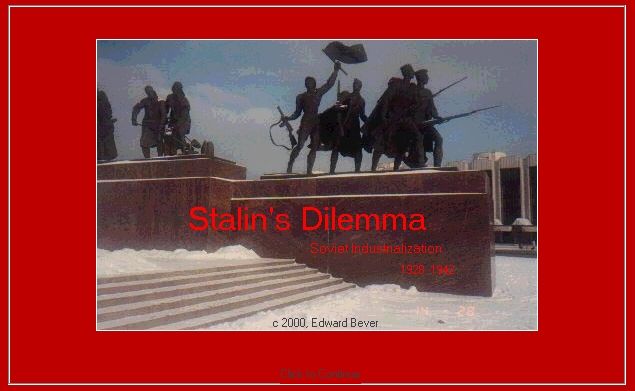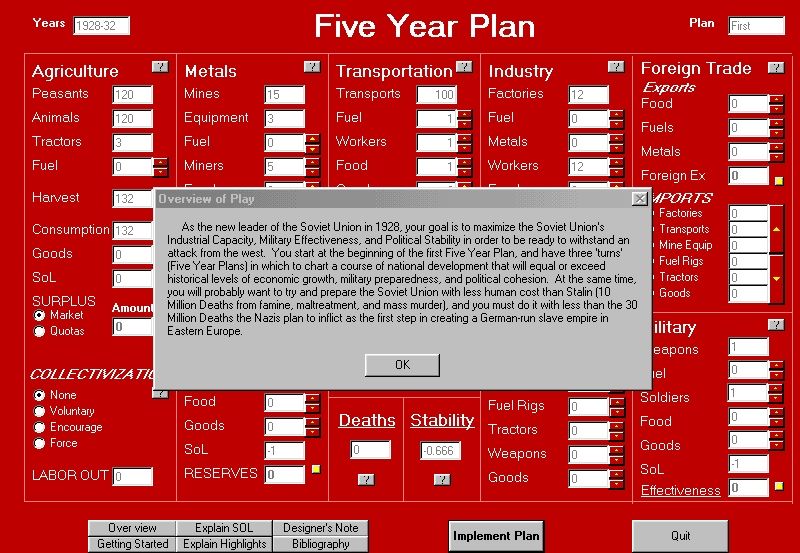Retro Replay Review
Gameplay
Stalin’s Dilemma offers a text-driven strategic simulation that challenges players to balance industrial growth, agricultural collectivization, and military preparedness over the pivotal years of 1928 to 1942. Each turn presents policy choices—allocating resources to factories, deciding grain quotas, or directing troop training—that carry immediate benefits but also long-term consequences. The depth of the simulation stems from interlocking systems: boost industry, and you risk agricultural shortfalls; prioritize the Red Army, and civilian welfare may suffer. These trade-offs force players to think like central planners, exploring the tension between rapid development and human cost.
The core interface is deceptively simple: menus of options, text reports, and highlighted metrics. Despite its minimal visual flair, the game’s real-time feedback loops are clear and informative. A color-coded highlighting system draws your eye to key statistics—food production, military morale, urbanization rates—making complex relationships more accessible. By adjusting sliders and approving policies, you directly observe cause-and-effect chains, reinforcing fundamental economic lessons on resource allocation and production limits.
Replaying Stalin’s Dilemma is where the strategy truly unfolds. Early missteps, like over-collectivizing farms without sufficient industrial support, can trigger famines, skyrocketing death tolls, and plummeting productivity. Later rounds encourage experimentation: what if you delay heavy industrial investment in favor of small-scale farming? Can you build up defensive forces faster than history did without collapsing the economy? Each campaign feels like a new puzzle, rewarding meticulous planning and adaptability in the face of shifting political and military pressures.
Graphics
Visually, Stalin’s Dilemma is nearly entirely text-based, resembling a classic terminal application rather than a modern graphical engine. While some may miss animated sprites or 3D battlefields, the game’s minimalist aesthetic is by design: it keeps the focus squarely on decision-making and data analysis. Menus are logically arranged, with clear typography and consistent color-coding that highlights critical variables such as production rates, civilian casualties, and military strength.
The simplicity of the interface belies its educational intent. There are no flashy cutscenes or ambient soundscapes—just straightforward text prompts and tables that update dynamically after each decision. This stripped-down presentation ensures that players aren’t distracted by superfluous visuals; instead, attention is paid to learning objectives. Teachers and history enthusiasts will appreciate how the interface prioritizes clarity over spectacle, making it an ideal classroom tool.
Despite its austere look, Stalin’s Dilemma incorporates visual cues that underscore the human element of policymaking. Color changes and warnings draw attention when resource shortages or casualty figures exceed critical thresholds. These subtle alerts transform a static grid of numbers into a living snapshot of the Soviet Union’s precarious balance, reinforcing the emotional weight behind each statistic.
Story
Although not a narrative-driven “story” in the traditional sense, Stalin’s Dilemma immerses players in a tightly woven historical scenario. You inherit a Soviet economy still reeling from revolution and civil war, tasked with catapulting the nation into a modern industrial powerhouse while averting mass suffering. The chronological structure guides you through collectivization campaigns, Five-Year Plans, and the ominous rise of fascist Germany, all punctuated by succinct text vignettes that recap major events and policy outcomes.
Every decision you make carries historical resonance. For instance, aggressively pushing for steel production may mirror the real-life successes of Magnitogorsk, but it also evokes the human toll of rapid industrialization. The program’s educational text boxes provide context on real casualty figures, peasant uprisings, and the looming threat of Operation Barbarossa, lending gravitas to your choices. Players gradually piece together not just the mechanics of resource management, but the moral and social complexities of Stalin’s era.
Victory in Stalin’s Dilemma isn’t measured by conquest or high scores but by your ability to reduce suffering and bolster national defense compared to historical outcomes. Achieving fewer civilian deaths than recorded history while maintaining a robust military feels like a hard-won narrative triumph. In this way, the game crafts its own emergent storyline—one shaped by your successes, failures, and the often-punishing interplay of economics and geopolitics.
Overall Experience
Stalin’s Dilemma stands out as both an educational resource and a deeply engaging strategy simulation. Its freeware distribution reflects a commitment to classroom use, making it readily accessible to students and history buffs alike. While modern gamers accustomed to flashy visuals may need to adjust to its text-heavy presentation, the payoff is a thoughtful, richly layered model of one of the 20th century’s most consequential periods.
The learning curve is gentle but exacting: introductory scenarios ease you into basic resource allocation, while longer campaigns demand mastery of complex interdependencies. The game’s emphasis on trade-offs and human impact fosters critical thinking, encouraging players to weigh ethical considerations alongside strategic goals. For educators, the built-in highlights and straightforward menus offer a seamless way to demonstrate macroeconomic principles in real time.
In an era of big-budget blockbusters, Stalin’s Dilemma reminds us that powerful gaming experiences can arise from pure design ingenuity and a clear educational mission. Its austere interface, robust simulation engine, and historical grounding combine to create a unique corner of the strategy genre. Whether you approach it as a teaching tool, a history lesson, or a rigorous strategic challenge, Stalin’s Dilemma delivers an experience that’s both mentally stimulating and surprisingly moving.
 Retro Replay Retro Replay gaming reviews, news, emulation, geek stuff and more!
Retro Replay Retro Replay gaming reviews, news, emulation, geek stuff and more!






Reviews
There are no reviews yet.